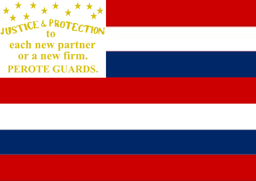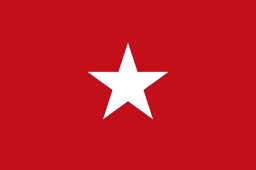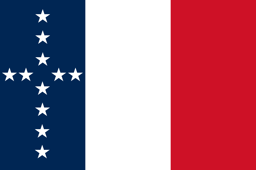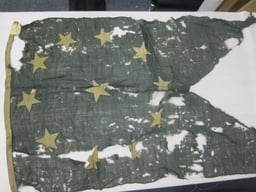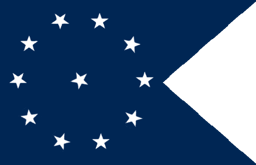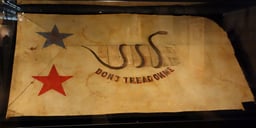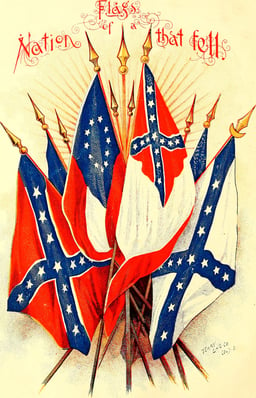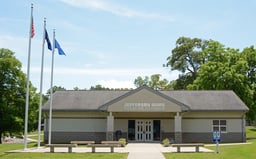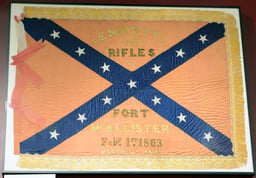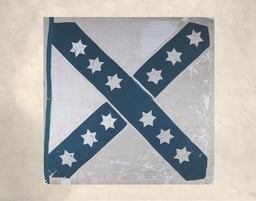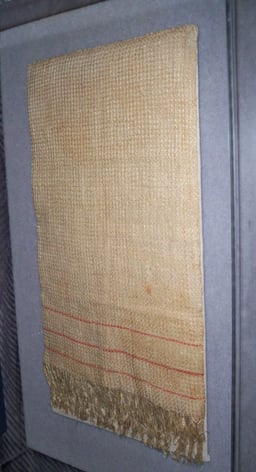Flags of the Confederate States of America
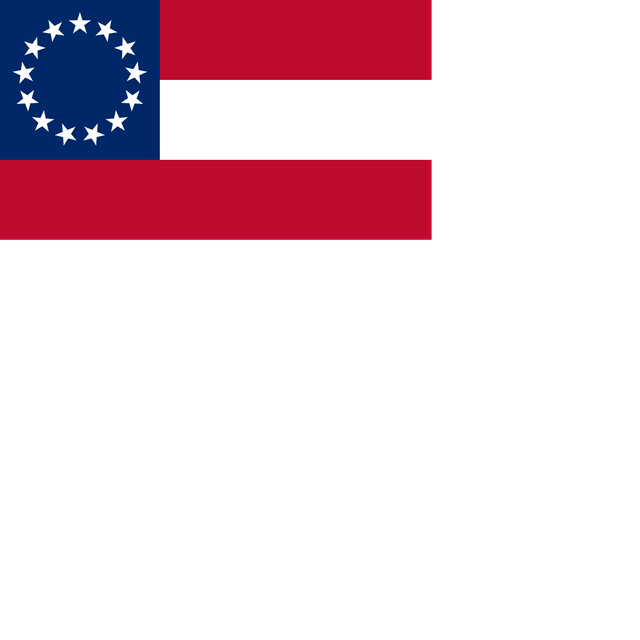
Flags of the Confederate States of America

| Name | "The Stars and Bars" |
|---|---|
| Use | National flag |
| Adopted | March 4, 1861 (first 7-star version)November 28, 1861 (final 13-star version) |
| Design | Three horizontal stripes of equal height, alternating red and white, with a blue square two-thirds the height of the flag as the canton.Inside the canton are white five-pointed stars of equal size, arranged in a circle and pointing outward. |
| Designed by | Nicola Marschall |
| Name | "The Stainless Banner"[1] |
| Use | National flag |
| Proportion | 1:2[2] |
| Adopted | May 1, 1863 |
| Design | A white rectangle two times as wide as it is tall, a red quadrilateral in the canton, inside the canton is a blue saltire with white outlining, with thirteen white five-pointed stars of equal size inside the saltire. |
| Name | "The Blood-Stained Banner" |
| Use | National flag |
| Proportion | 2:3 |
| Adopted | March 4, 1865 |
| Design | A white rectangle, one-and-a-half times as wide as it is tall, a red vertical stripe on the far right of the rectangle, a red quadrilateral in the canton, inside the canton is a blue saltire with white outlining, with thirteen white five-pointed stars of equal size inside the saltire.[3] |
| Designed by | Arthur L. Rogers[16] |
Three successive designs served as the official national flag of the Confederate States of America (the "Confederate States" or the "Confederacy") during its existence from 1861 to 1865.
Since the end of the American Civil War, private and official use of the Confederacy's flags, and of flags with derivative designs, has continued amid philosophical, political, cultural, and racial controversy in the United States. These include flags displayed in states; cities, towns and counties; schools, colleges and universities; private organizations and associations; and by individuals.
The state flag of Mississippi features the Confederate army's battle flag in the canton, or upper left corner, the only current U.S. state flag to do so. The state flag of Georgia is very similar to the first national flag of the Confederacy, the "Stars and Bars"; a prior design incorporating the Confederate battle flag was in use from 1956 until 2001.
| Name | "The Stars and Bars" |
|---|---|
| Use | National flag |
| Adopted | March 4, 1861 (first 7-star version)November 28, 1861 (final 13-star version) |
| Design | Three horizontal stripes of equal height, alternating red and white, with a blue square two-thirds the height of the flag as the canton.Inside the canton are white five-pointed stars of equal size, arranged in a circle and pointing outward. |
| Designed by | Nicola Marschall |
| Name | "The Stainless Banner"[1] |
| Use | National flag |
| Proportion | 1:2[2] |
| Adopted | May 1, 1863 |
| Design | A white rectangle two times as wide as it is tall, a red quadrilateral in the canton, inside the canton is a blue saltire with white outlining, with thirteen white five-pointed stars of equal size inside the saltire. |
| Name | "The Blood-Stained Banner" |
| Use | National flag |
| Proportion | 2:3 |
| Adopted | March 4, 1865 |
| Design | A white rectangle, one-and-a-half times as wide as it is tall, a red vertical stripe on the far right of the rectangle, a red quadrilateral in the canton, inside the canton is a blue saltire with white outlining, with thirteen white five-pointed stars of equal size inside the saltire.[3] |
| Designed by | Arthur L. Rogers[16] |
First flag: the "Stars and Bars" (1861–1863)
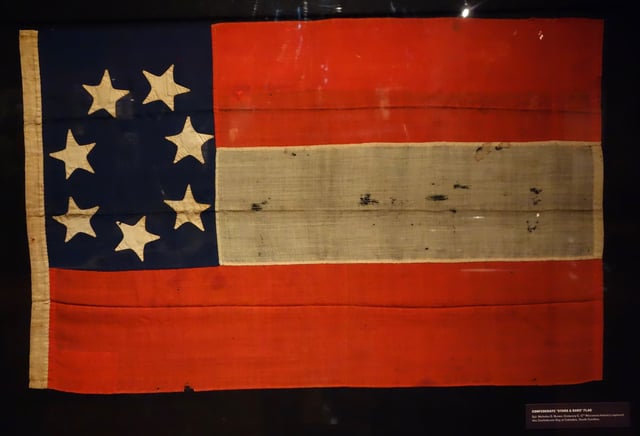
A Confederate "Stars and Bars" flag, captured by soldiers of the Union Army at Columbia, South Carolina.
The first official national flag of the Confederacy, often called the Stars and Bars, flew from March 4, 1861, to May 1, 1863. It was designed by German/Prussian artist Nicola Marschall in Marion, Alabama, and resembled the Flag of Austria, with which Marschall would have been familiar.[18][19] The "Stars and Bars" flag was adopted March 4, 1861, in the first temporary national capital of Montgomery, Alabama, and raised over the dome of that first Confederate capitol. Marschall also designed the Confederate army uniform.[19]
A monument in Louisburg, North Carolina, claims the "Stars and Bars" "was designed by a son of North Carolina / Orren Randolph Smith / and made under his direction by / Catherine Rebecca (Murphy) Winborne. / Forwarded to Montgomery, Ala. Feb 12, 1861, / Adopted by the Provisional Congress March 4, 1861".[20]
One of the first acts of the Provisional Confederate Congress was to create the Committee on the Flag and Seal, chaired by William Porcher Miles, a congressman and Fire-Eater from South Carolina. The committee asked the public to submit thoughts and ideas on the topic and was, as historian John M. Coski puts it, "overwhelmed by requests not to abandon the 'old flag' of the United States." Miles had already designed a flag that later became known as the Confederate Battle Flag, and he favored his flag over the "Stars and Bars" proposal. But given the popular support for a flag similar to the U.S. flag ("the Stars and Stripes" – originally established and designed in June 1777 during the Revolutionary War), the "Stars and Bars" design was approved by the committee.[21]
When the American Civil War broke out, the "Stars and Bars" caused confusion on the battlefield at the First Battle of Bull Run because of its similarity to the U.S. flag, especially when it was hanging limp, down on the flagstaff.[22] The "Stars and Bars" was also criticized on ideological grounds for its resemblance to the U.S. flag. Many Confederates disliked the Stars and Bars, seeing it as symbolic of a centralized federal power the Confederate states were seceding from.[23] As early as April 1861, a month after the flag's adoption, some were already criticizing the flag, calling it a "servile imitation" and a "detested parody" of the U.S. flag.[24] In January 1862, George William Bagby, writing for the Southern Literary Messenger, wrote that many Confederates disliked the flag. "Every body wants a new Confederate flag," Bagby wrote. "The present one is universally hated. It resembles the Yankee flag and that is enough to make it unutterably detestable." The editor of the Charleston Mercury expressed a similar view: "It seems to be generally agreed that the 'Stars and Bars' will never do for us. They resemble too closely the dishonored 'Flag of Yankee Doodle' … we imagine that the 'Battle Flag' will become the Southern Flag by popular acclaim." William T. Thompson, the editor of the Savannah-based Daily Morning News also objected to the flag, due to its aesthetic similarity to the U.S. flag, which for some Confederates had negative associations with emancipation and abolitionism. Thompson stated in April 1863 that he disliked the adopted flag "on account of its resemblance to that of the abolition despotism against which we are fighting."[4][4][4][4][4][4][4]
Over the course of the flag's use by the Confederacy, additional stars were added to the flag's canton, eventually bringing the total number of stars on the flag to thirteen.
This reflected the Confederacy's claims of having admitted Kentucky and Missouri into the Confederacy. Although they were represented in the Confederate Congress for the duration of its meetings, and had shadow governments made up of deposed former state politicians, neither state was ever fully controlled or administered by the Confederacy. The first showing of the 13-star flag was outside the Ben Johnson House in Bardstown, Kentucky; the 13-star design was also in use as the Confederate navy's battle ensign.
Second flag: the "Stainless Banner" (1863–1865)
During the solicitation for a second Confederate national flag, many different types of designs were proposed, nearly all based on the battle flag, which by 1863 had become well-known and popular among those living in the Confederacy. The Confederate Congress specified that the new design be a white field "...with the union (now used as the battle flag) to be a square of two-thirds the width of the flag, having the ground red; thereupon a broad saltire of blue, bordered with white, and emblazoned with mullets or five-pointed stars, corresponding in number to that of the Confederate States."[4]
The flag is also known as the Stainless Banner, and the matter of the person behind its design remains a point of contention. On April 23, 1863, the Savannah Morning News editor William Tappan Thompson, with assistance from William Ross Postell, a Confederate blockade runner, published an editorial championing a design featuring the battle flag on a white background he referred to later as "The White Man's Flag."[4] In explaining the white background, Thompson wrote, "As a people we are fighting to maintain the Heaven-ordained supremacy of the white man over the inferior or colored race; a white flag would thus be emblematical of our cause."[4][4][4][4][4][4][4][4] In a letter to Confederate Congressman C. J. Villeré, dated April 24, 1863, a design similar to Thompson's was proposed by General P. G. T. Beauregard, "whose earlier penchant for practicality had established the precedent for visual distinctiveness on the battlefield, proposed that 'a good design for the national flag would be the present battle-flag as Union Jack, and the rest all white or all blue'....The final version of the second national flag, adopted May 1, 1863, did just this: it set the St. Andrew's Cross of stars in the Union Jack with the rest of the civilian banner entirely white."[26][27][28][29][30][31][32][33]
The Confederate Congress debated whether the white field should have a blue stripe and whether it should be bordered in red.
William Miles delivered a speech supporting the simple white design that was eventually approved.
He argued that the battle flag must be used, but for a national flag it was necessary to emblazon it, but as simply as possible, with a plain white field.[34] When Thompson received word the Congress had adopted the design with a blue stripe, he published an editorial on April 28 in opposition, writing that "the blue bar running up the centre of the white field and joining with the right lower arm of the blue cross, is in bad taste, and utterly destructive of the symmetry and harmony of the design."[4][4] Confederate Congressman Peter W. Gray proposed the amendment that gave the flag its white field.[35] Gray stated that the white field represented "purity, truth and freedom."[36]
Regardless of who truly originated the design of the Stainless Banner, whether by heeding Thompson's editorials or Beauregard's letter, the Stainless Banner was officially adopted by the Confederate Congress on May 1, 1863.
The flags that were actually produced by the Richmond Clothing Depot used the 1.5:1 ratio adopted for the Confederate navy's battle ensign, rather than the official 2:1 ratio.[4]
Initial reaction to the second national flag was favorable, but over time it became criticized for being "too white."
Military officers also voiced complaints about the flag being too white, for various reasons, such as the danger of being mistaken for a flag of truce, especially on naval ships, and that it was too easily soiled.[16] The Columbia-based Daily South Carolinian observed that it was essentially a battle flag upon a flag of truce and might send a mixed message. Due to the flag's resemblance to one of truce, some Confederate soldiers cut off the white portion of the flag, leaving only the canton.[37]
The first official use of the "Stainless Banner" was to drape the coffin of General Thomas J. "Stonewall" Jackson as it lay in state in the Virginia capitol, May 12, 1863.[38]
Third flag: the "Blood-Stained Banner" (1865)
The third national flag (also called the "Blood-Stained Banner") was adopted March 4, 1865.
The red vertical bar was proposed by Major Arthur L. Rogers, who argued that the pure white field of the Second National flag could be mistaken as a flag of truce: when hanging limp in no wind, the flag's "Southern Cross" canton could accidentally stay hidden, so the flag could mistakenly appear all white.
Rogers lobbied successfully to have this alteration introduced in the Confederate Senate.
He defended his redesign as having "as little as possible of the Yankee blue", and described it as symbolizing the primary origins of the people of the Confederacy, with the saltire of the Scottish flag and the red bar from the flag of France.[16]
The Flag Act of 1865, passed by the Confederate congress near the very end of the War, describes the flag in the following language:
The Congress of the Confederate States of America do enact, That the flag of the Confederate States shall be as follows: The width two-thirds of its length, with the union (now used as the battle flag) to be in width three-fifths of the width of the flag, and so proportioned as to leave the length of the field on the side of the union twice the width of the field below it; to have the ground red and a broad blue saltire thereon, bordered with white and emblazoned with mullets or five pointed stars, corresponding in number to that of the Confederate States; the field to be white, except the outer half from the union to be a red bar extending the width of the flag.[4]
Despite the passage of the Flag Act of 1865, very few of these third national flags were actually manufactured and put into use in the field, with many Confederates never seeing the flag.
Moreover, the ones made by the Richmond Clothing Depot used the square canton of the second national flag rather than the slightly rectangular one that was specified by the law.[4]
Other flags
In addition to the national flags of the Confederacy, a wide variety of flags and banners were flown by Southerners during the Civil War.
Most famously, the "Bonnie Blue Flag" was used as an unofficial flag during the early months of 1861. It was flying above the Confederate batteries that first opened fire on Fort Sumter in Charleston harbor, in South Carolina beginning the Civil War. The "Van Dorn battle flag" was also carried by Confederate troops fighting in the Trans-Mississippi and Western theaters of war. In addition, many military units had their own regimental flags they would carry into battle.[39]
Flags of individual Confederate states
Battle flag

Three versions of the flag of the Confederate States of America and the Confederate Battle Flag are shown on this printed poster from 1896.

The Battle Flag of the Army of Northern Virginia

Battle flag of Forrest's Cavalry Corps, 1863–65

The battle flag used by the Army of the Trans-Mississippi
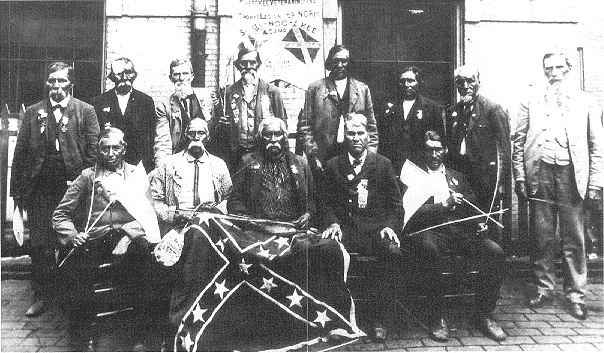
Cherokee Confederates reunion in New Orleans, 1903
At the First Battle of Manassas, near Manassas, Virginia, the similarity between the "Stars and Bars" and the "Stars and Stripes" caused confusion and military problems. Regiments carried flags to help commanders observe and assess battles in the warfare of the era. At a distance, the two national flags were hard to tell apart.[40] In addition, Confederate regiments carried many other flags, which added to the possibility of confusion.
After the battle, General P. G. T. Beauregard wrote that he was "resolved then to have [our flag] changed if possible, or to adopt for my command a 'Battle flag', which would be Entirely different from any State or Federal flag."[22] He turned to his aide, who happened to be William Porcher Miles, the former chairman of the Confederate Congress's Committee on the Flag and Seal. Miles described his rejected national flag design to Beauregard. Miles also told the Committee on the Flag and Seal about the general's complaints and request that the national flag be changed. The committee rejected the idea by a four-to-one vote, after which Beauregard proposed the idea of having two flags. He described the idea in a letter to his commanding General Joseph E. Johnston: "I wrote to [Miles] that we should have 'two' flags—a 'peace' or parade flag, and a 'war' flag to be used only on the field of battle—but congress having adjourned no action will be taken on the matter—How would it do us to address the War Dept. on the subject of Regimental or badge flags made of red with two blue bars crossing each other diagonally on which shall be introduced the stars,... We would then on the field of battle know our friends from our Enemies."[22]
The flag that Miles had favored when he was chairman of the "Committee on the Flag and Seal" eventually became the battle flag and, ultimately, the most popular flag of the Confederacy.
According to Museum of the Confederacy Director John Coski, Miles' design was inspired by one of the many "secessionist flags" flown at the South Carolina secession convention in Charleston of December 1860. That flag was a blue St George's Cross (an upright or Latin cross) on a red field, with 15 white stars on the cross, representing the slaveholding states,[41][42] and, on the red field, palmetto and crescent symbols. Miles received a variety of feedback on this design, including a critique from Charles Moise, a self-described "Southerner of Jewish persuasion." Moise liked the design but asked that "...the symbol of a particular religion not be made the symbol of the nation." Taking this into account, Miles changed his flag, removing the palmetto and crescent, and substituting a heraldic saltire ("X") for the upright cross. The number of stars was changed several times as well. He described these changes and his reasons for making them in early 1861. The diagonal cross was preferable, he wrote, because "it avoided the religious objection about the cross (from the Jews and many Protestant sects), because it did not stand out so conspicuously as if the cross had been placed upright thus." He also argued that the diagonal cross was "more Heraldric [sic] than Ecclesiastical, it being the 'saltire' of Heraldry, and significant of strength and progress."[43]
According to Coski, the Saint Andrew's Cross (also used on the flag of Scotland as a white saltire on a blue field) had no special place in Southern iconography at the time, and if Miles had not been eager to conciliate the Southern Jews, his flag would have used the traditional upright "Saint George's Cross" (as used on the flag of England, a red cross on a white field). A colonel named James B. Walton submitted a battle flag design essentially identical to Miles' except with an upright Saint George's cross, but Beauregard chose the diagonal cross design.[44]
Miles' flag and all the flag designs up to that point were rectangular ("oblong") in shape.
General Johnston suggested making it square to conserve material.
Johnston also specified the various sizes to be used by different types of military units.
Generals Beauregard and Johnston and Quartermaster General Cabell approved the design of the 12-star Confederate Battle Flag at the Ratcliffe home, which served briefly as Beauregard's headquarters, near Fairfax Court House in September 1861. The 12th star represented Missouri. President Jefferson Davis arrived by train at Fairfax Station soon after and was shown the design for the new battle flag at the Ratcliffe House. Hetty Cary and her sister and cousin made prototypes. One such 12-star flag resides in the collection of Richmond's Museum of the Confederacy and the other is in the Confederate Memorial Hall Museum in New Orleans.
On November 28, 1861, Confederate soldiers in General Robert E. Lee's newly reorganized Army of Northern Virginia received the new battle flags in ceremonies at Centreville and Manassas, Virginia, and carried them throughout the Civil War. Beauregard gave a speech encouraging the soldiers to treat the new flag with honor and that it must never be surrendered. Many soldiers wrote home about the ceremony and the impression the flag had upon them, the "fighting colors" boosting morale after the confusion at the Battle of First Manassas. From then on, the battle flag grew in its identification with the Confederacy and the South in general.[45] The flag's stars represented the number of states in the Confederacy. The distance between the stars decreased as the number of states increased, reaching thirteen when the secessionist factions of Kentucky and Missouri joined in late 1861.[46]
The Army of Northern Virginia battle flag assumed a prominent place post-war when it was adopted as the copyrighted emblem of the United Confederate Veterans.
Its continued use by the Southern Army's post-war veterans groups, the United Confederate Veterans (U.C.V.) and the later Sons of Confederate Veterans, (S.C.V.), and elements of the design by related similar female descendants organizations of the United Daughters of the Confederacy, (U.D.C.), led to the assumption that it was, as it has been termed, "the soldier's flag" or "the Confederate battle flag".
The square "battle flag" is also properly known as "the flag of the Army of Northern Virginia". It was sometimes called "Beauregard's flag" or "the Virginia battle flag". A Virginia Department of Historic Resources marker declaring Fairfax, Virginia as the birthplace of the Confederate battle flag was dedicated on April 12, 2008, near the intersection of Main and Oak Streets, in Fairfax, Virginia.[47][48][49]
Naval jacks and ensigns
The fledgling Confederate States Navy adopted and used several types of flags, banners, and pennants aboard all CSN ships: jacks, battle ensigns, and small boat ensigns, as well as commissioning pennants, designating flags, and signal flags.
The First Confederate Navy jacks, in use from 1861 to 1863, consisted of a circle of seven to fifteen five-pointed white stars against a field of "medium blue." It was flown forward aboard all Confederate warships while they were anchored in port. One seven-star jack still exists today (found aboard the captured ironclad CSS Atlanta) that is actually "dark blue" in color (see illustration below, left).[50]
The Second Confederate Navy Jack was a rectangular cousin of the Confederate Army's battle flag and was in use from 1863 until 1865.
It existed in a variety of dimensions and sizes, despite the CSN's detailed naval regulations.
The blue color of the diagonal saltire's "Southern Cross" was much lighter than the dark blue of the battle flag.[50]
The first national flag, also known as the Stars and Bars (see above), served from 1861 to 1863 as the Confederate Navy's first battle ensign. It was generally made with an aspect ratio of 2:3, but a few very wide 1:2 ratio ensigns still survive today in museums and private collections. As the Confederacy grew, so did the numbers of white stars seen on the ensign's dark blue canton: seven-, nine-, eleven-, and thirteen-star groupings were typical. Even a few fourteen- and fifteen-starred ensigns were made to include states that were expected to secede but never completely joined the Confederacy.
The second national flag was later adapted as a naval ensign, using a shorter 2:3 ratio than the 1:2 ratio adopted by the Confederate Congress for the national flag. This particular battle ensign was the only example taken around the world, finally becoming the last Confederate flag lowered in the Civil War; this happened aboard CSS Shenandoah
Controversy

An elongated (2:1 aspect ratio) version of the Battle Flag of the Army of Northern Virginia, and similar to The Second Confederate Navy Jack, in use from 1863 until 1865, although with the darker blue field of the Army's battle flag.
Despite never having historically represented the Confederate States of America as a country, nor having been officially recognized as one of its national flags, the rectangular Second Confederate Navy Jack and the Battle Flag of the Army of Northern Virginia are now flag types commonly referred to as the Confederate Flag. Both have become a widely recognized symbol of the Southern United States.[51] It is also known as the rebel flag, Dixie flag, and Southern cross [52] and is sometimes incorrectly referred to as the Stars and Bars.[53] The actual "Stars and Bars" is the first national flag, which used an entirely different design, and was in use by the Confederacy until mid-1863.
As of the early 21st century, the "rebel flag" has become a highly divisive symbol in the United States.[54]














